Operation and Multi-Objective Design Optimization of a Plate Heat Exchanger with Zigzag Flow Channel Geometry
Abstract
1. Introduction
2. Methodology
2.1. Model and Experimental Setup
2.2. Optimization of Operation Conditions by the Taguchi Method and Analysis of Variance (ANOVA)
2.3. Schematic of the PHE Model
2.4. Theoretical Model and Numerical Simulation
2.5. Genetic Algorithm for Multi-Objective Optimization
3. Results and Discussion
3.1. Operating Factor Analysis by the Taguchi Method
3.2. ANOVA Analysis
3.3. Effect of Geometric Parameters of the Zigzag Flow Channel
3.4. Optimization of Flow Channel Geometry by NSGA-II
4. Conclusions
Author Contributions
Funding
Institutional Review Board Statement
Data Availability Statement
Acknowledgments
Conflicts of Interest
References
- Su, Z.; Zhang, M.; Xu, P.; Zhao, Z.; Wang, Z.; Huang, H.; Quyang, T. Opportunities and strategies for multigrade waste heat utilization in various industries: A recent review. Energy Convers. Manag. 2021, 229, 113769. [Google Scholar] [CrossRef]
- Papapetrou, M.; Kosmadakis, G.; Cipollina, A.; La Commare, U.; Micale, G. Industrial waste heat: Estimation of the technically available resource in the EU per industrial sector, temperature level and country. Appl. Therm. Eng. 2018, 138, 207–216. [Google Scholar] [CrossRef]
- Forman, C.; Muritala, I.K.; Pardemann, R.; Meyer, B. Estimating the global waste heat potential. Renew. Sustain. Energy Rev. 2016, 57, 1568–1579. [Google Scholar] [CrossRef]
- Chen, W.-H.; Uribe, M.C.; Kwon, E.E.; Lin, K.-Y.A.; Park, Y.-K.; Ding, L.; Saw, L.H. A comprehensive review of thermoelectric generation optimization by statistical approach: Taguchi method, analysis of variance (ANOVA), and response surface methodology (RSM). Renew. Sustain. Energy Rev. 2022, 169, 112917. [Google Scholar] [CrossRef]
- Jouhara, H.; Khordehgah, N.; Almahmoud, S.; Delpech, B.; Chauhan, A.; Tassou, S.A. Waste heat recovery technologies and applications. Therm. Sci. Eng. Prog. 2018, 6, 268–289. [Google Scholar] [CrossRef]
- Xie, J.Y.; Chueh, C.-C.; Chen, W.-H.; Chen, K.J. Heat transfer performance comparison of printed circuit heat exchangers with straight, zigzag and serpentine flow channels for waste heat recovery. Int. J. Energy Res. 2022, 46, 1722–1735. [Google Scholar] [CrossRef]
- Omidi, M.; Farhadi, M.; Jafari, M. A comprehensive review on double pipe heat exchangers. Appl. Therm. Eng. 2017, 110, 1075–1090. [Google Scholar] [CrossRef]
- Wang, Q.; Chen, G.; Chen, Q.; Zeng, M. Review of Improvements on Shell-and-Tube Heat Exchangers With Helical Baffles. Heat Transf. Eng. 2010, 31, 836–853. [Google Scholar] [CrossRef]
- Abu-Khader, M.M. Plate heat exchangers: Recent advances. Renew. Sustain. Energy Rev. 2012, 16, 1883–1891. [Google Scholar] [CrossRef]
- Fei, N.C.; Mehat, N.M.; Kamaruddin, S. Practical Applications of Taguchi Method for Optimization of Processing Parameters for Plastic Injection Moulding: A Retrospective Review. ISRN Ind. Eng. 2013, 2013, 462174. [Google Scholar] [CrossRef]
- Singh, O.P.; Kumar, G.; Kumar, M. Role of Taguchi and Grey Relational Method in Optimization of Machining Parameters of Different Materials: A Review. Acta Electron. Malays. (AEM) 2019, 3, 19–22. [Google Scholar] [CrossRef]
- Jamshidi, N.; Farhadi, M.; Ganji, D.D.; Sedighi, K. Experimental analysis of heat transfer enhancement in shell and helical tube heat exchangers. Appl. Therm. Eng. 2013, 51, 644–652. [Google Scholar] [CrossRef]
- Kotcioglu, I.; Khalaji, M.N.; Cansiz, A. Heat transfer analysis of a rectangular channel having tubular router in different winglet configurations with Taguchi method. Appl. Therm. Eng. 2018, 132, 637–650. [Google Scholar] [CrossRef]
- Rao, R.V.; Patel, V.K. Thermodynamic optimization of cross flow plate-fin heat exchanger using a particle swarm optimization algorithm. Int. J. Therm. Sci. 2010, 49, 1712–1721. [Google Scholar] [CrossRef]
- Selbaş, R.; Kızılkan, Ö.; Reppich, M. A new design approach for shell-and-tube heat exchangers using genetic algorithms from economic point of view. Chem. Eng. Process. Process Intensif. 2006, 45, 268–275. [Google Scholar] [CrossRef]
- Liu, C.; Bu, W.; Xu, D. Multi-objective shape optimization of a plate-fin heat exchanger using CFD and multi-objective genetic algorithm. Int. J. Heat Mass Transf. 2017, 111, 65–82. [Google Scholar] [CrossRef]
- Wang, J.; Wang, M.; Li, M.; Xia, J.; Dai, Y. Multi-objective optimization design of condenser in an organic Rankine cycle for low grade waste heat recovery using evolutionary algorithm. Int. Commun. Heat Mass Transf. 2013, 45, 47–54. [Google Scholar] [CrossRef]
- Raja, B.D.; Jhala, R.L.; Patel, V. Many-objective optimization of shell and tube heat exchanger. Therm. Sci. Eng. Prog. 2017, 2, 87–101. [Google Scholar] [CrossRef]
- Sanaye, S.; Hajabdollahi, H. Thermal-economic multi-objective optimization of plate fin heat exchanger using genetic algorithm. Appl. Energy 2010, 87, 1893–1902. [Google Scholar] [CrossRef]
- Raja, B.D.; Patel, V.; Jhala, R.L. Thermal design and optimization of fin-and-tube heat exchanger using heat transfer search algorithm. Therm. Sci. Eng. Prog. 2017, 4, 45–57. [Google Scholar] [CrossRef]
- Yang, Y.; Li, H.; Yao, M.; Zhang, Y.; Zhang, C.; Zhang, L.; Wu, S. Optimizing the size of a printed circuit heat exchanger by multi-objective genetic algorithm. Appl. Therm. Eng. 2020, 167, 114811. [Google Scholar] [CrossRef]
- Imran, M.; Pambudi, N.A.; Farooq, M. Thermal and hydraulic optimization of plate heat exchanger using multi objective genetic algorithm. Case Stud. Therm. Eng. 2017, 10, 570–578. [Google Scholar] [CrossRef]
- Zhao, Z.; Zhou, Y.; Ma, X.; Chen, X.; Li, S.; Yang, S. Effect of Different Zigzag Channel Shapes of PCHEs on Heat Transfer Performance of Supercritical LNG. Energies. 2019, 12, 2085. [Google Scholar] [CrossRef]
- Zohuri, B. RETRACTED CHAPTER: Heat Exchanger Types and Classifications. In Retracted Book: Compact Heat Exchangers: Selection, Application, Design and Evaluation; Zohuri, B., Ed.; Springer International Publishing: Cham, Denmark, 2017; pp. 19–56. [Google Scholar]
- Chen, W.-H.; Wang, J.-S.; Chang, M.-H.; Mutuku, J.K.; Hoang, A.T. Efficiency improvement of a vertical-axis wind turbine using a deflector optimized by Taguchi approach with modified additive method. Energy Convers. Manag. 2021, 245, 114609. [Google Scholar] [CrossRef]
- Kim, D.E.; Kim, M.H.; Cha, J.E.; Kim, S.O. Numerical investigation on thermal–hydraulic performance of new printed circuit heat exchanger model. Nucl. Eng. Des. 2008, 238, 3269–3276. [Google Scholar] [CrossRef]
- Kim, I.H.; Zhang, X.; Christensen, R.; Sun, X. Design study and cost assessment of straight, zigzag, S-shape, and OSF PCHEs for a FLiNaK–SCO2 Secondary Heat Exchanger in FHRs. Ann. Nucl. Energy 2016, 94, 129–137. [Google Scholar] [CrossRef]
- Xu, T.; Zhao, H.; Wang, M.; Qi, J. Numerical Study of Thermal-Hydraulic Performance of a New Spiral Z-Type PCHE for Supercritical CO2 Brayton Cycle. Energies 2021, 14, 4417. [Google Scholar] [CrossRef]
- Aneesh, A.M.; Sharma, A.; Srivastava, A.; Chaudhury, P. Effects of wavy channel configurations on thermal-hydraulic characteristics of Printed Circuit Heat Exchanger (PCHE). Int. J. Heat Mass Transf. 2018, 118, 304–315. [Google Scholar] [CrossRef]
- Shin, M.-S.; Park, N.; Park, M.-J.; Cheon, J.-Y.; Kang, J.K.; Jun, K.-W.; Ha, K.-S. Modeling a channel-type reactor with a plate heat exchanger for cobalt-based Fischer–Tropsch synthesis. Fuel Process. Technol. 2014, 118, 235–243. [Google Scholar] [CrossRef]
- Lee, D.S.; Morillo, C.; Bugeda, G.; Oller, S.; Onate, E. Multilayered composite structure design optimisation using distributed/parallel multi-objective evolutionary algorithms. Compos. Struct. 2012, 94, 1087–1096. [Google Scholar] [CrossRef]
- Wang, Z.; Rangaiah, G.P. Application and Analysis of Methods for Selecting an Optimal Solution from the Pareto-Optimal Front obtained by Multiobjective Optimization. Ind. Eng. Chem. Res. 2017, 56, 560–574. [Google Scholar] [CrossRef]
- Yoon, S.-J.; O’Brien, J.; Chen, M.; Sabharwall, P.; Sun, X. Development and validation of Nusselt number and friction factor correlations for laminar flow in semi-circular zigzag channel of printed circuit heat exchanger. Appl. Therm. Eng. 2017, 123, 1327–1344. [Google Scholar] [CrossRef]
- Zhang, H.; Guo, J.; Huai, X.; Cheng, K.; Cui, X. Studies on the thermal-hydraulic performance of zigzag channel with supercritical pressure CO2. J. Supercrit. Fluids 2019, 148, 104–115. [Google Scholar] [CrossRef]
- Chen, W.-H.; Chen, C.-Y.; Huang, C.-Y.; Hwang, C.-J. Power output analysis and optimization of two straight-bladed vertical-axis wind turbines. Appl. Energy 2017, 185, 223–232. [Google Scholar] [CrossRef]
- Chen, C.-C.; Tseng, H.-H.; Lin, Y.-L.; Chen, W.-H. Hydrogen production and carbon dioxide enrichment from ethanol steam reforming followed by water gas shift reaction. J. Clean. Prod. 2017, 162, 1430–1441. [Google Scholar] [CrossRef]
- Attalla, M.; Maghrabie, H.M. Investigation of effectiveness and pumping power of plate heat exchanger with rough surface. Chem. Eng. Sci. 2020, 211, 115277. [Google Scholar] [CrossRef]
- Arpia, A.A.; Chen, W.-H.; Ubando, A.T.; Tabatabaei, M.; Lam, S.S.; Culaba, A.B.; De Luna, M.D.G. Catalytic microwave-assisted torrefaction of sugarcane bagasse with calcium oxide optimized via Taguchi approach: Product characterization and energy analysis. Fuel 2021, 305, 121543. [Google Scholar] [CrossRef]
- San, F.G.B.; Isik-Gulsac, I.; Okur, O. Analysis of the polymer composite bipolar plate properties on the performance of PEMFC (polymer electrolyte membrane fuel cells) by RSM (response surface methodology). Energy 2013, 55, 1067–1075. [Google Scholar]
- Figley, J.; Sun, X.; Mylavarapu, S.K.; Hajek, B. Numerical study on thermal hydraulic performance of a Printed Circuit Heat Exchanger. Prog. Nucl. Energy 2013, 68, 89–96. [Google Scholar] [CrossRef]
- Chen, W.-H.; Lin, Y.-Y.; Liu, H.-C.; Baroutian, S. Optimization of food waste hydrothermal liquefaction by a two-step process in association with a double analysis. Energy 2020, 199, 117438. [Google Scholar] [CrossRef]
- Chen, W.-H.; Chiu, G.-L.; Ong, H.C.; Lam, S.S.; Lim, S.; Ok, Y.S.; Kwom, E.E. Optimization and analysis of syngas production from methane and CO2 via Taguchi approach, response surface methodology (RSM) and analysis of variance (ANOVA). Fuel 2021, 296, 120642. [Google Scholar] [CrossRef]
- Tu, Y.; Zeng, Y. Numerical Study on Flow and Heat Transfer Characteristics of Supercritical CO2 in Zigzag Microchannels. Energies 2022, 15, 2099. [Google Scholar] [CrossRef]
- Wang, B.; Shen, J.; Cheng, J.; Wang, Y. Numerical Improvement Using Flow and Heat Transfer Calculations of the Zigzag Geometry for Carbon Dioxide PCHEs. Energies 2022, 15, 2831. [Google Scholar] [CrossRef]
- Hajabdollahi, H.; Ahmadi, P.; Dincer, I. Exergetic Optimization of Shell-and-Tube Heat Exchangers Using NSGA-II. Heat Transfer Engineering. Heat Transf. Eng. 2012, 33, 618–628. [Google Scholar] [CrossRef]
- Chen, W.-H.; Mutuku, J.K.; Yang, Z.-W.; Hwang, C.-J.; Lee, W.J.; Ashokkumar, V. An investigation for airflow and deposition of PM2.5 contaminated with SAR-CoV-2 virus in healthy and diseased human airway. Environ. Res. 2021, 197, 111096. [Google Scholar] [CrossRef]
- Mutuku, J.K.; Hou, W.-C.; Chen, W.-H. An Overview of Experiments and Numerical Simulations on Airflow and Aerosols Deposition in Human Airways and the Role of Bioaerosol Motion in COVID-19 Transmission. Aerosol Air Qual. Res. 2020, 20, 1172–1196. [Google Scholar] [CrossRef]
- Zheng, Z.; Fletcher, D.F.; Haynes, B.S. Transient laminar heat transfer simulations in periodic zigzag channels. Int. J. Heat Mass Transf. 2014, 71, 758–768. [Google Scholar] [CrossRef]
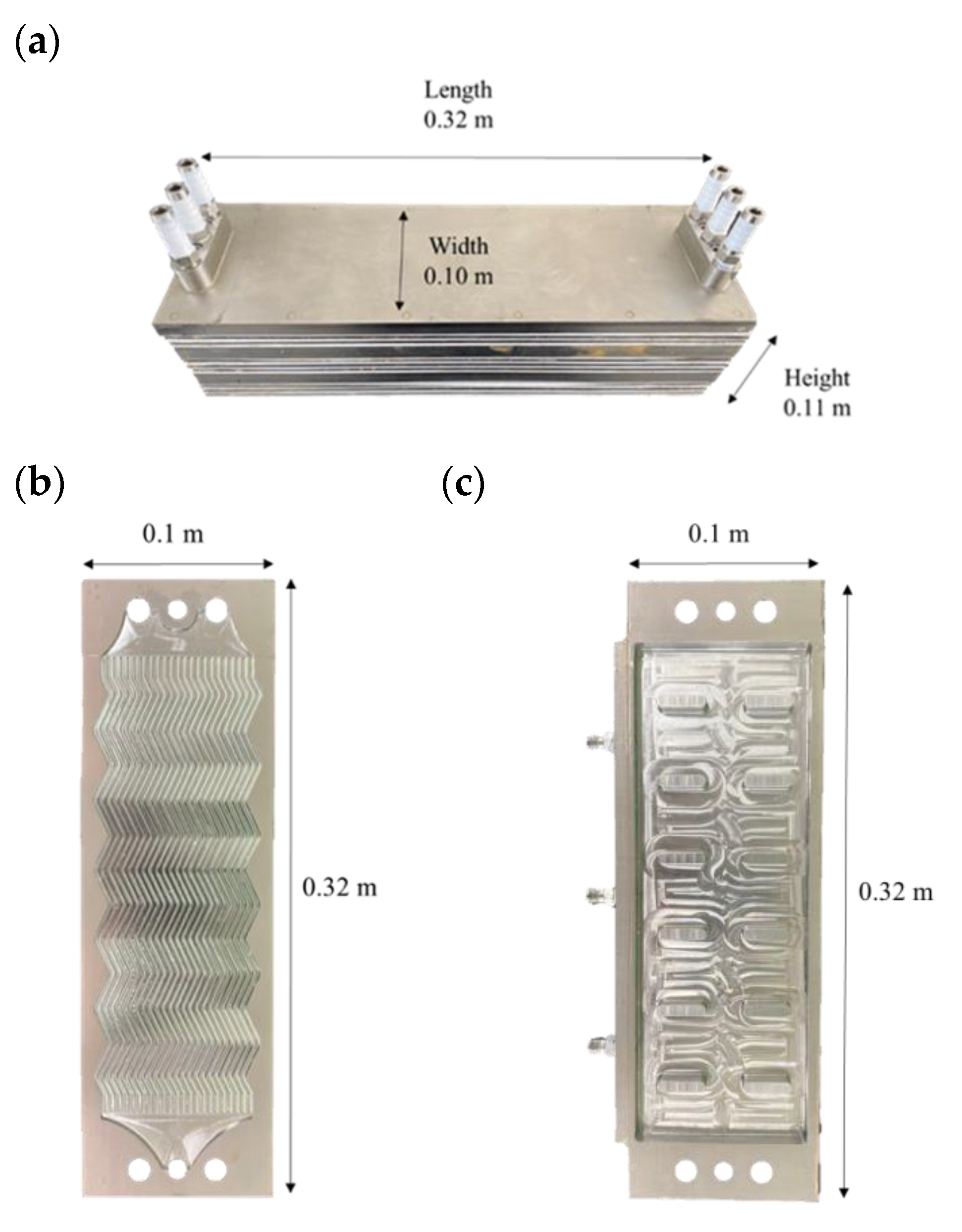
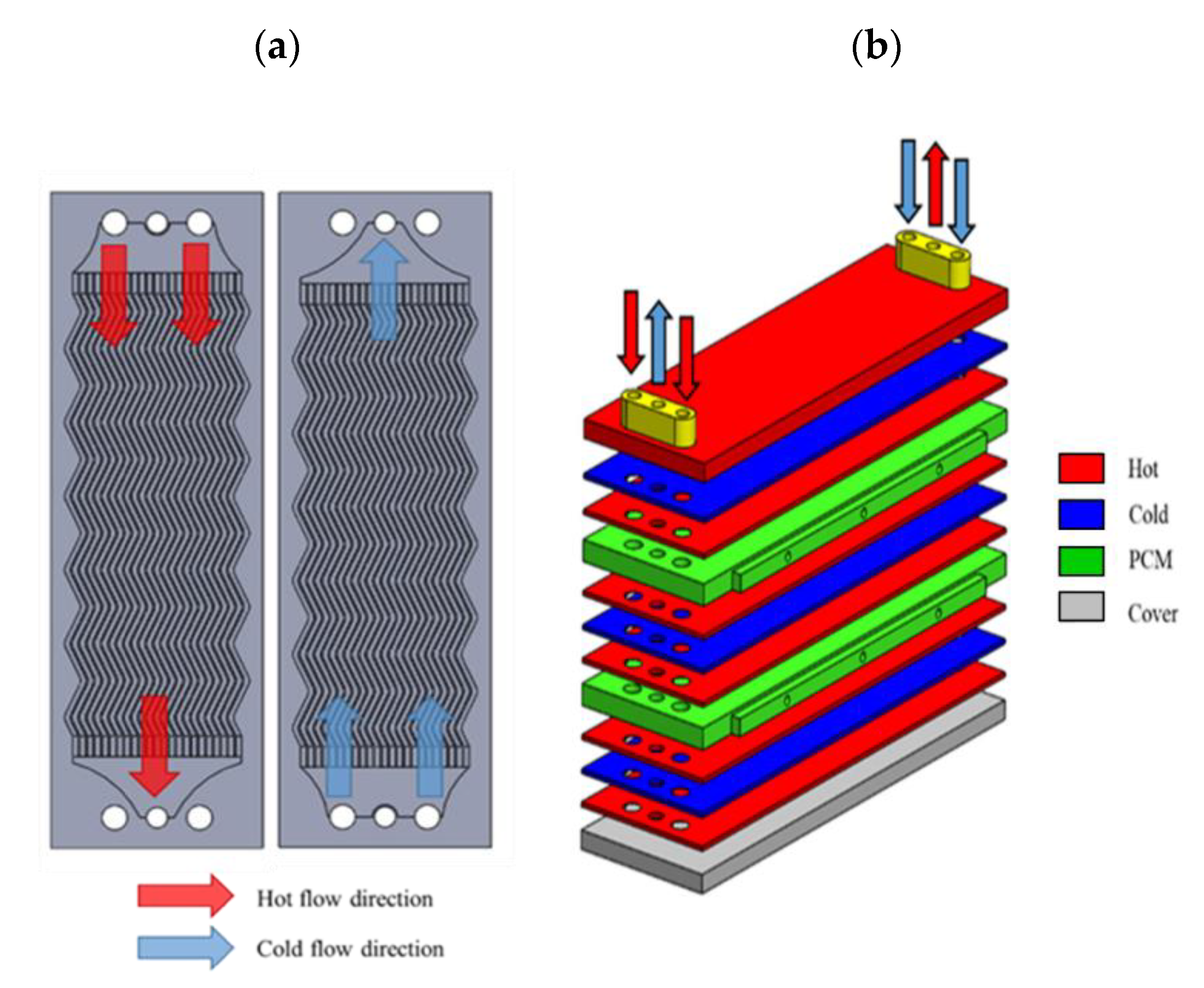
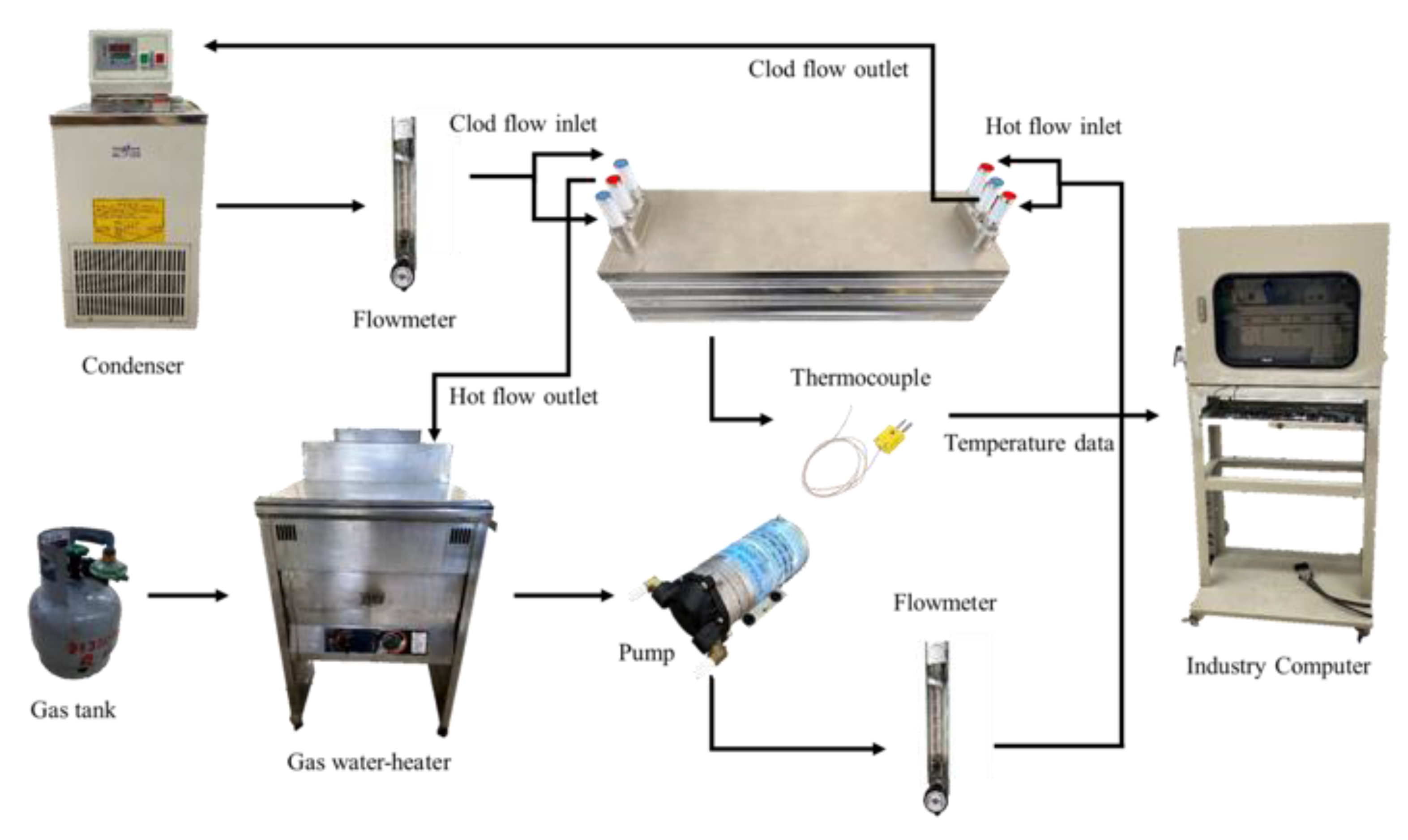
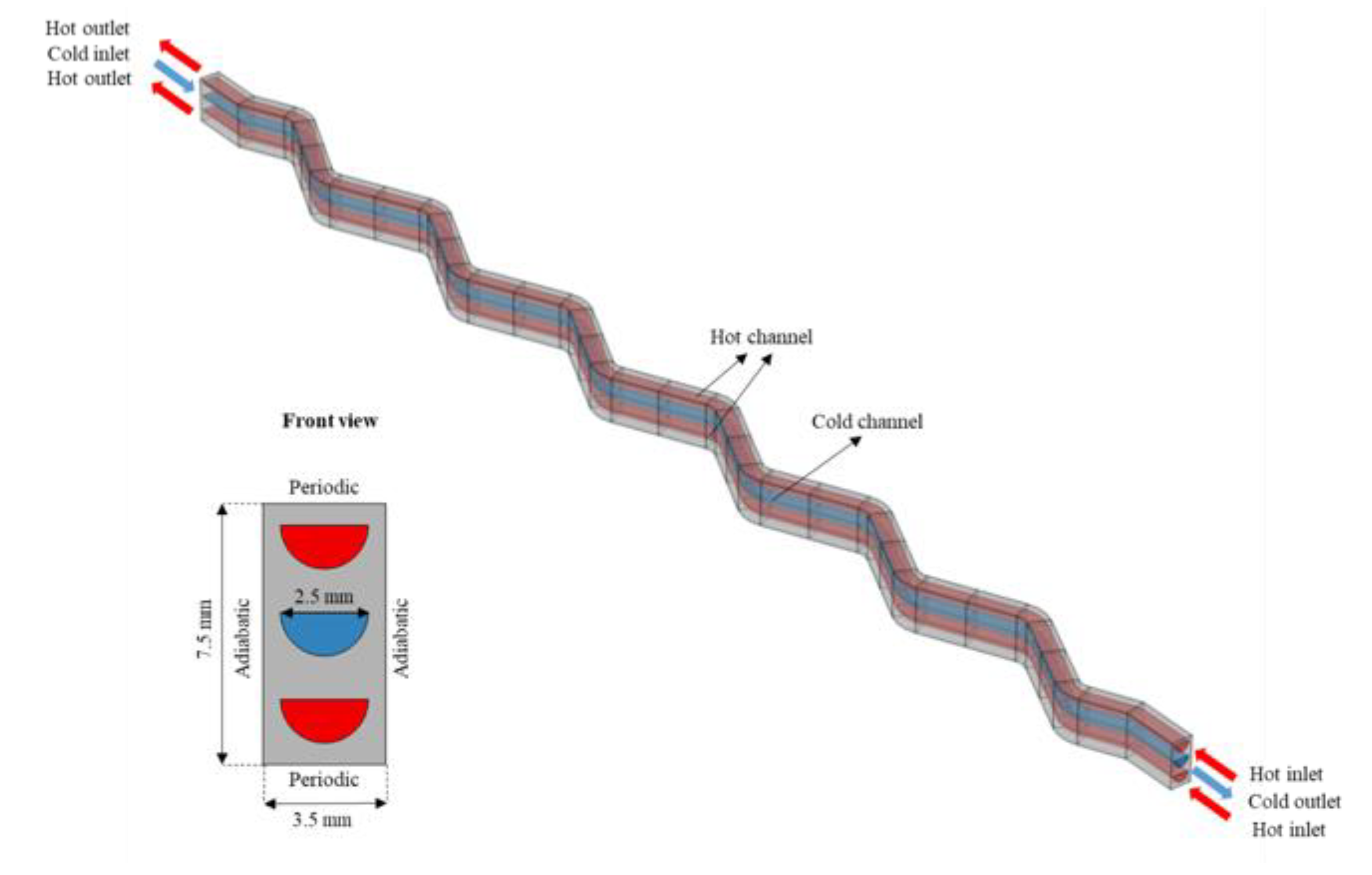
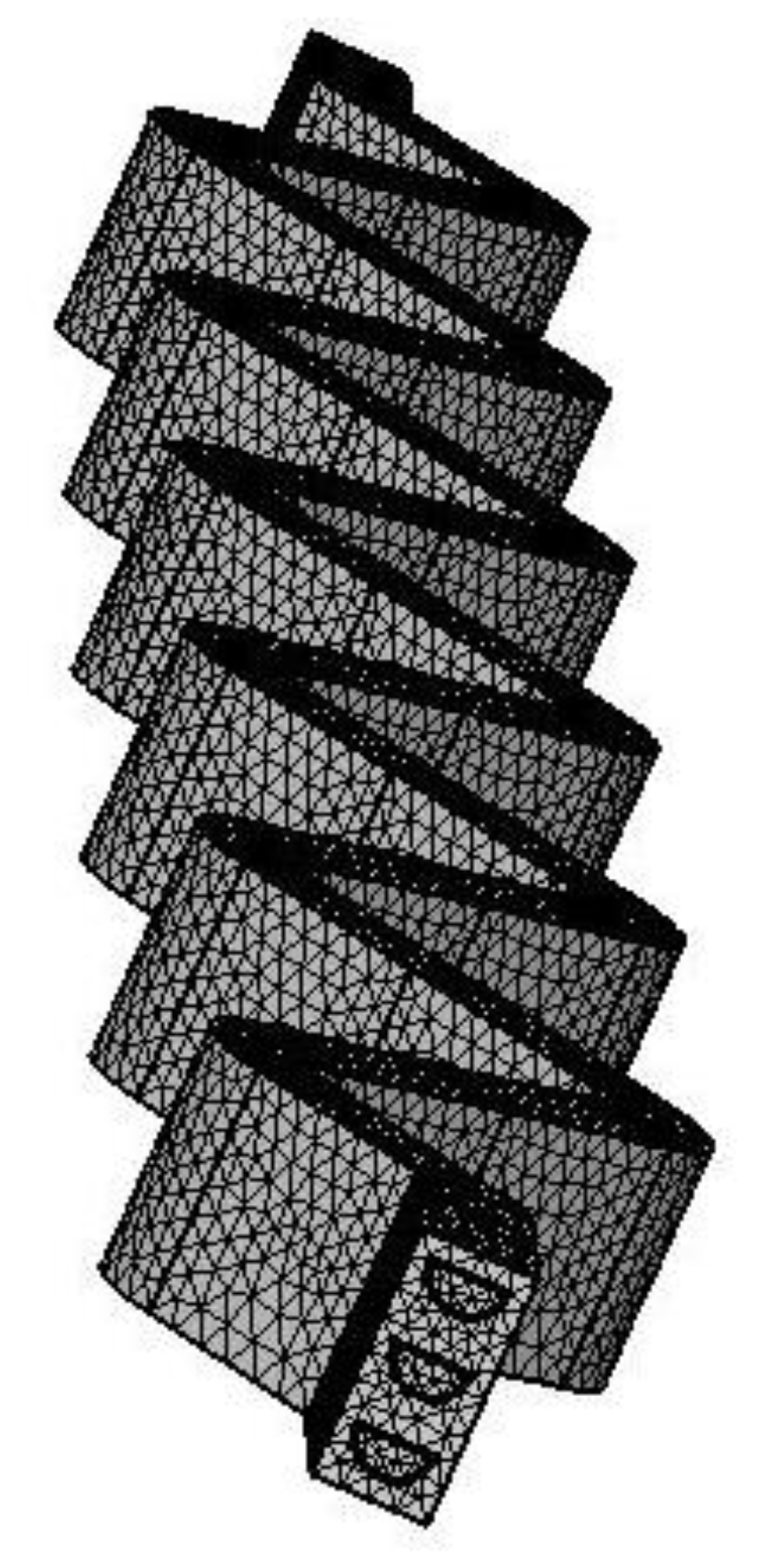
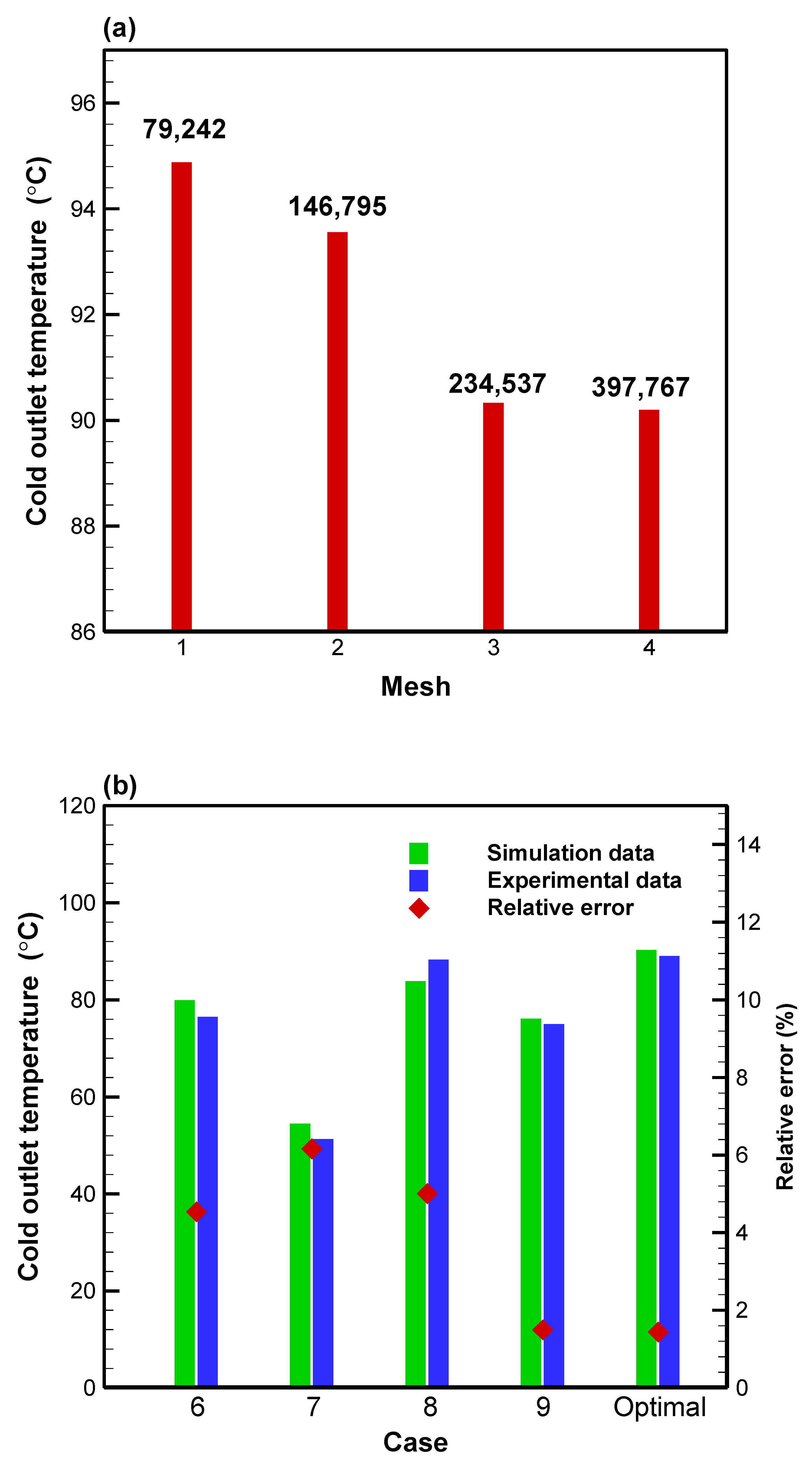
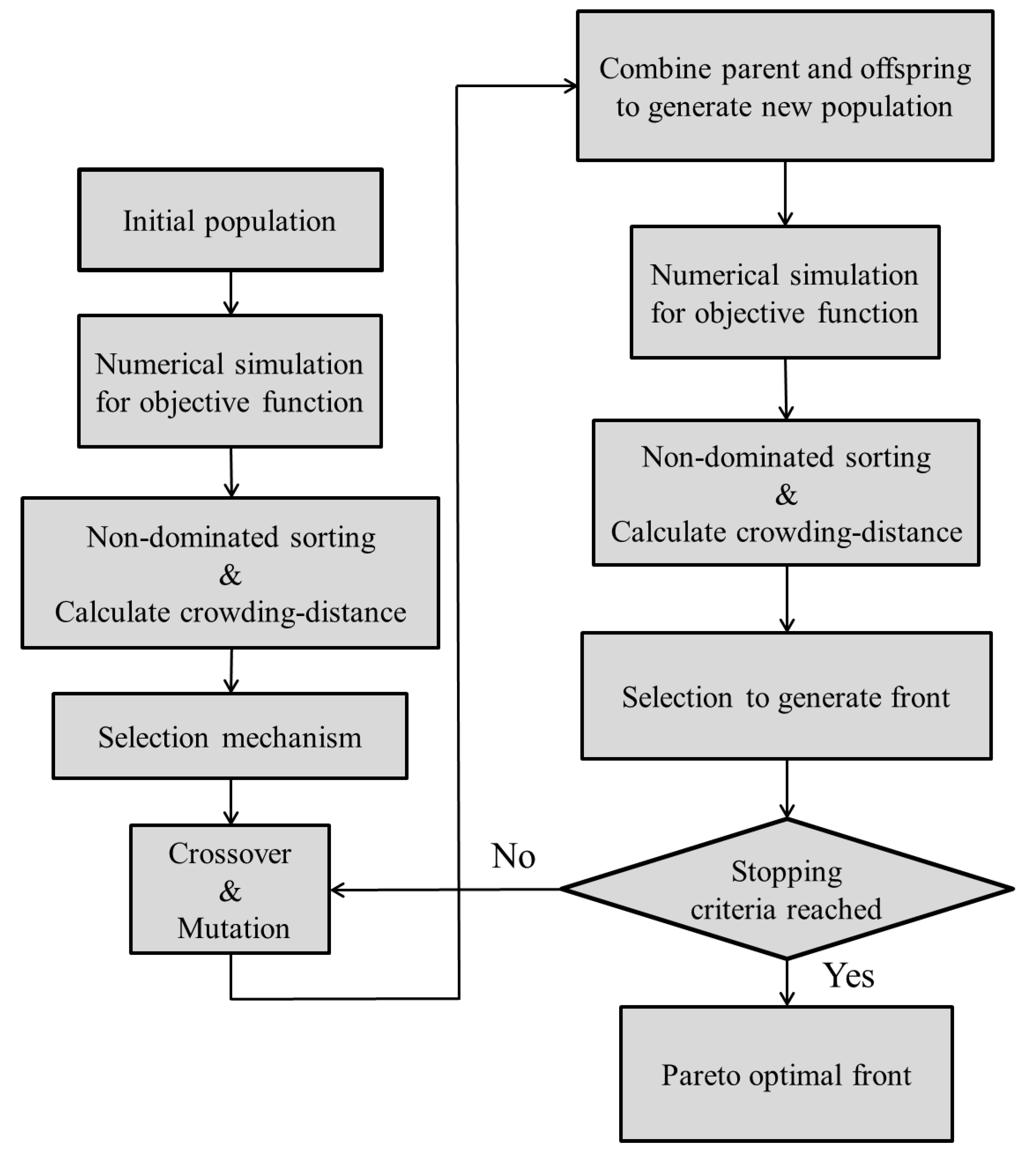
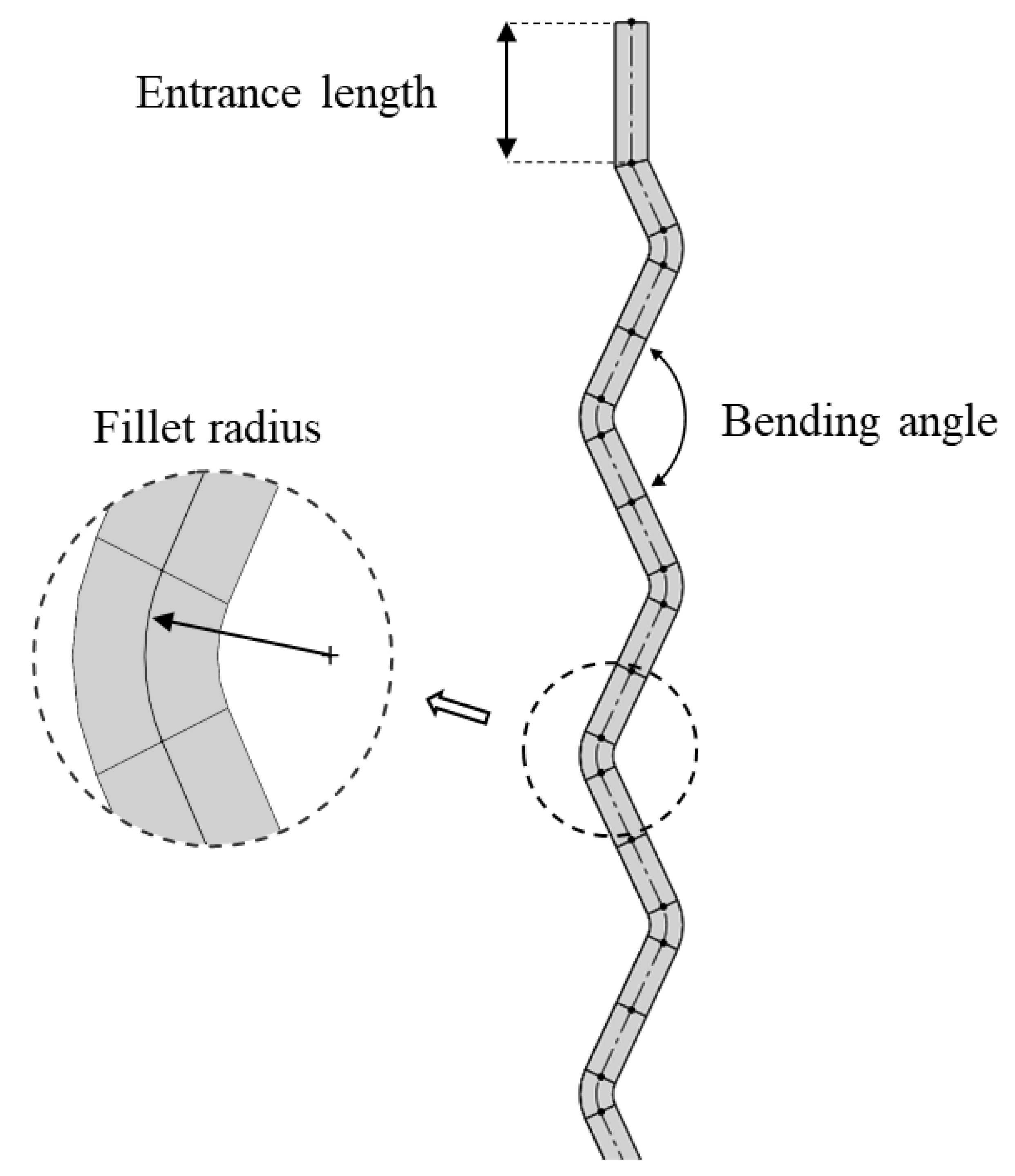
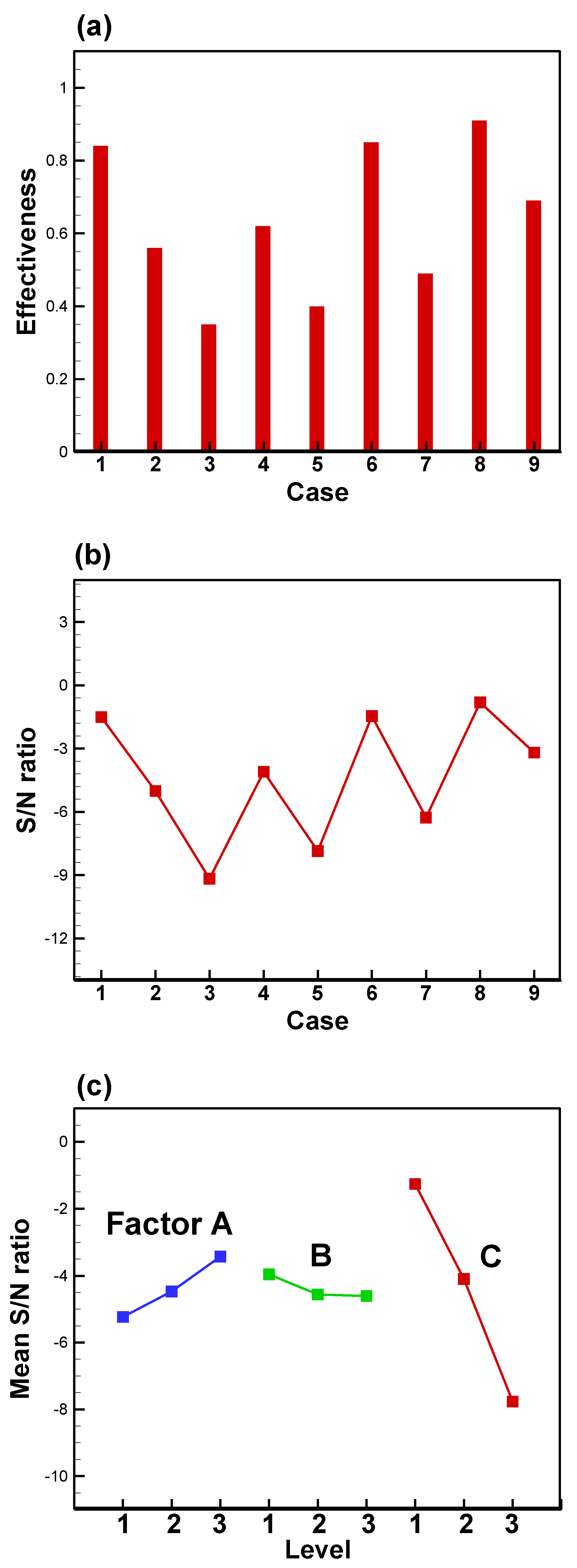
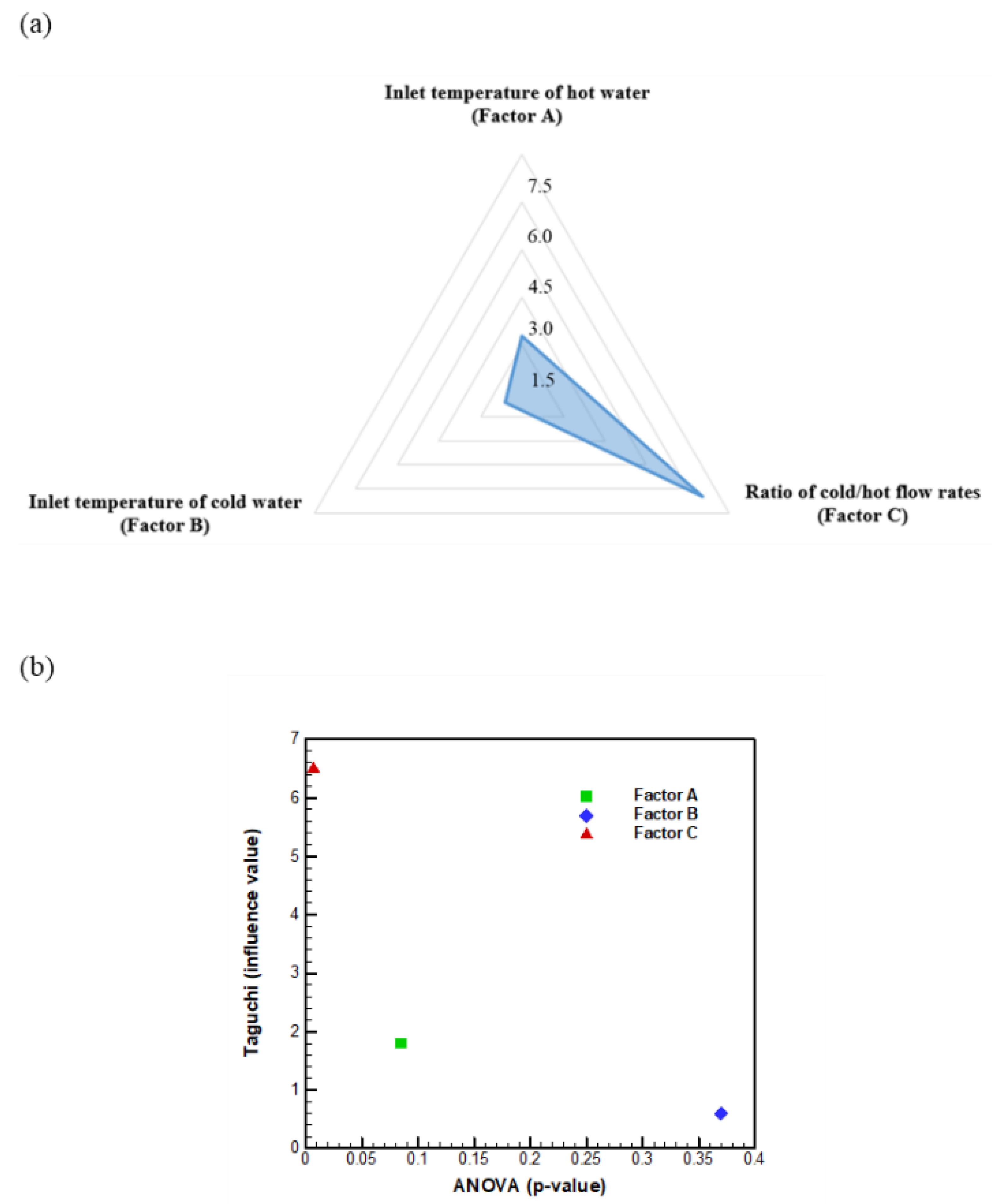
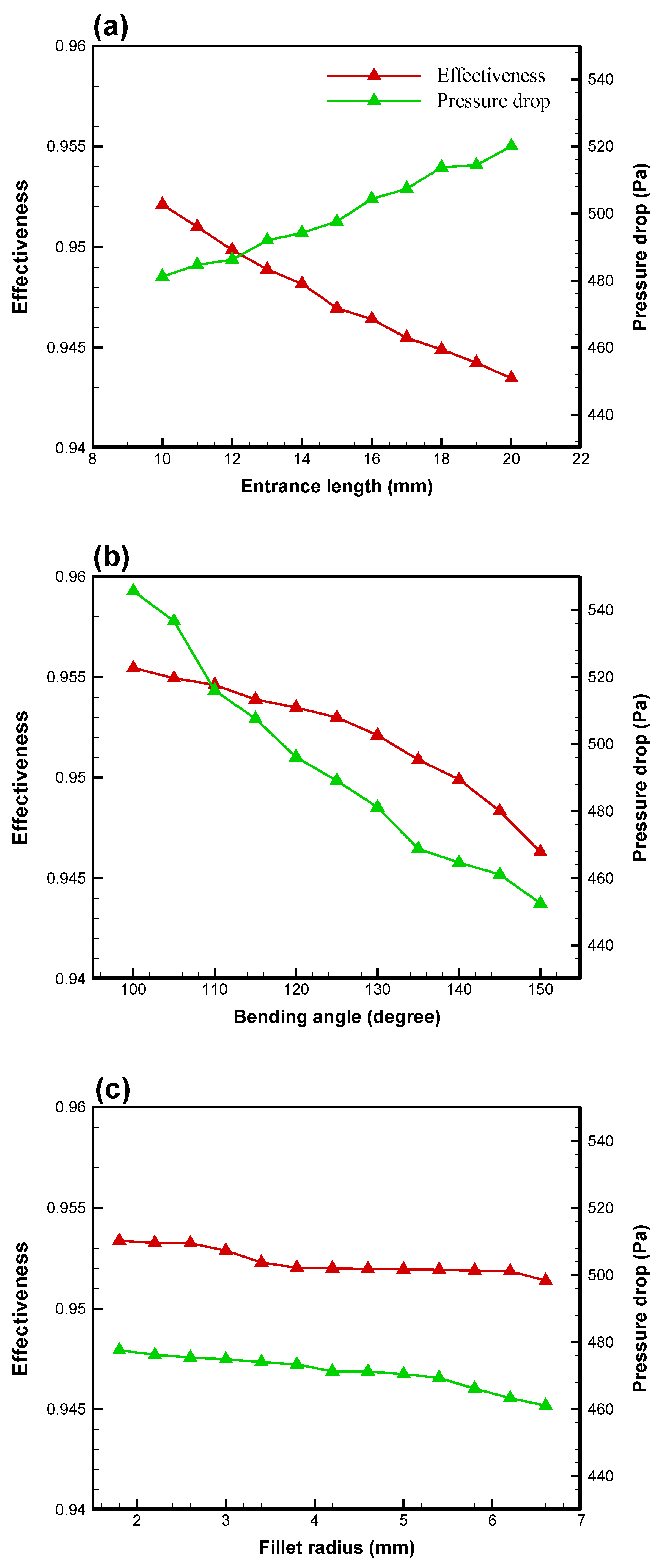
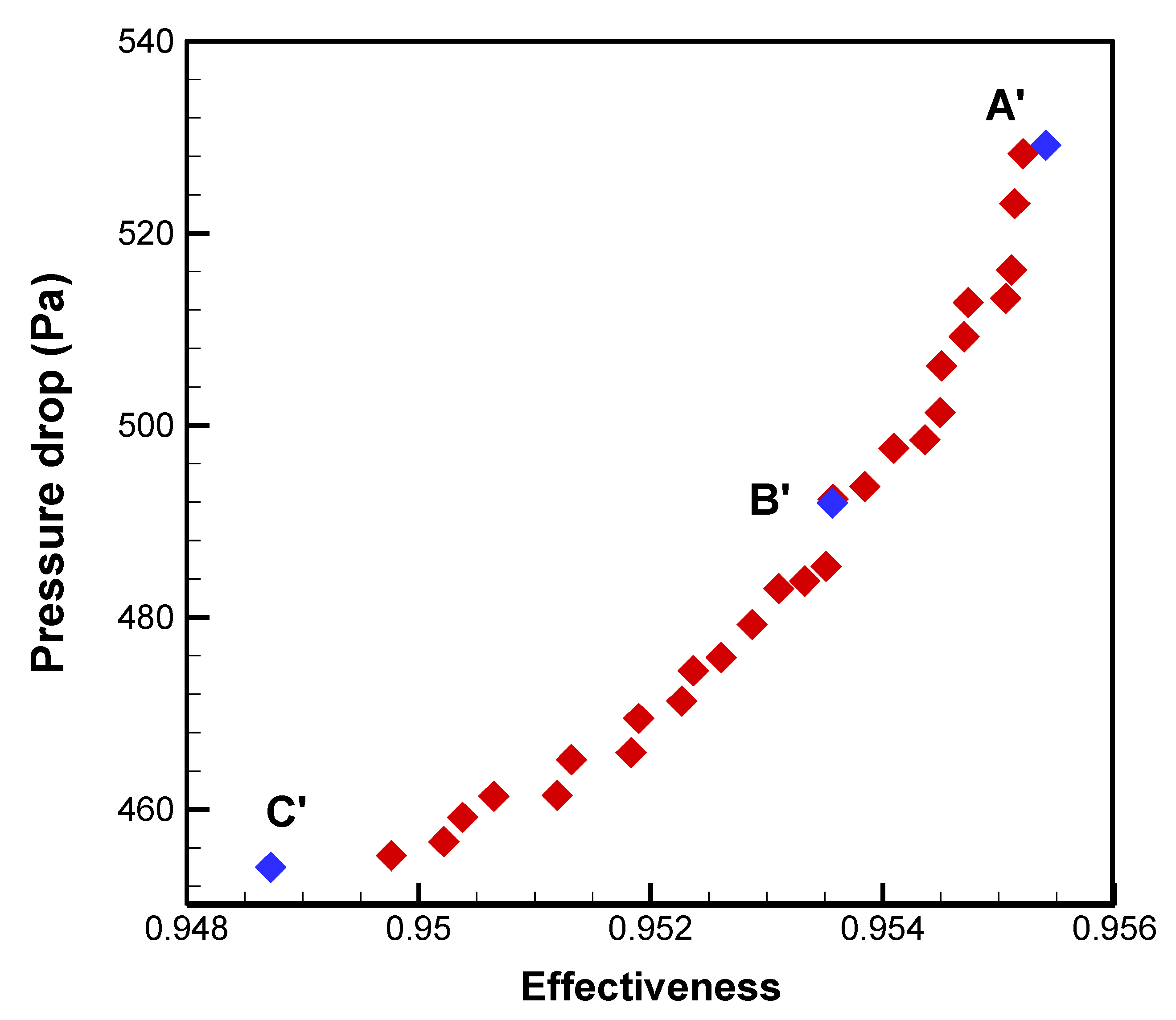


| Heat Exchanger | Working Fluid | Objective Function | Ref. |
|---|---|---|---|
| Plate-fin heat exchanger | Air | Maximize: Colburn factor Minimize: friction factor | [16] |
| Plate heat exchanger | R134a and water | Maximize: heat transfer surface area Minimize: pressure drop | [17] |
| Shell and tube heat exchanger | Oil and water | Maximize: effectiveness Minimize: pressure drop, cost, and entropy generation | [18] |
| Plate-fin heat exchanger | Air | Maximize: effectiveness Minimize: total annual cost | [19] |
| Fin-and-tube heat exchanger | Air and water | Minimize: total weight Minimize: total annual cost | [20] |
| Printed circuit heat exchanger | CO2 | Maximize: temperature rise Minimize: pressure drop | [21] |
| Factor | Control Parameter | Level | ||
|---|---|---|---|---|
| 1 | 2 | 3 | ||
| A | Inlet temperature of hot water (°C) | 75 | 85 | 95 |
| B | Inlet temperature of cold water (°C) | 10 | 20 | 30 |
| C | Flow rate ratio of cold/hot water flows * | 0.25 | 0.5 | 1 |
| Case | Factor | ||
|---|---|---|---|
| A | B | C | |
| 1 | 1 | 1 | 1 |
| 2 | 1 | 2 | 2 |
| 3 | 1 | 3 | 3 |
| 4 | 2 | 1 | 2 |
| 5 | 2 | 2 | 3 |
| 6 | 2 | 3 | 1 |
| 7 | 3 | 1 | 3 |
| 8 | 3 | 2 | 1 |
| 9 | 3 | 3 | 2 |
| Factor | DF | Adj SS | Adj MS | F-Value | p-Value |
|---|---|---|---|---|---|
| A | 2 | 4.9371 | 2.4686 | 10.73 | 0.085 |
| B | 2 | 0.7832 | 0.3916 | 1.70 | 0.370 |
| C | 2 | 63.8308 | 31.9154 | 138.74 | 0.007 |
| Residual Error | 2 | 0.4601 | 0.2300 | ||
| Total | 8 |
| Design Point | Geometric Parameters | Objective Function | |||
|---|---|---|---|---|---|
| Entrance Length (mm) | Bending Angle (degree) | Fillet Radius (mm) | Effectiveness | Pressure Drop (Pa) | |
| A′ | 10 | 100.1 | 6.18 | 0.955 | 529 |
| B′ | 10 | 117.2 | 6.17 | 0.953 | 492 |
| C′ | 10 | 144.0 | 6.09 | 0.948 | 454 |
Publisher’s Note: MDPI stays neutral with regard to jurisdictional claims in published maps and institutional affiliations. |
© 2022 by the authors. Licensee MDPI, Basel, Switzerland. This article is an open access article distributed under the terms and conditions of the Creative Commons Attribution (CC BY) license (https://creativecommons.org/licenses/by/4.0/).
Share and Cite
Chen, W.-H.; Li, Y.-W.; Chang, M.-H.; Chueh, C.-C.; Ashokkumar, V.; Saw, L.H. Operation and Multi-Objective Design Optimization of a Plate Heat Exchanger with Zigzag Flow Channel Geometry. Energies 2022, 15, 8205. https://doi.org/10.3390/en15218205
Chen W-H, Li Y-W, Chang M-H, Chueh C-C, Ashokkumar V, Saw LH. Operation and Multi-Objective Design Optimization of a Plate Heat Exchanger with Zigzag Flow Channel Geometry. Energies. 2022; 15(21):8205. https://doi.org/10.3390/en15218205
Chicago/Turabian StyleChen, Wei-Hsin, Yi-Wei Li, Min-Hsing Chang, Chih-Che Chueh, Veeramuthu Ashokkumar, and Lip Huat Saw. 2022. "Operation and Multi-Objective Design Optimization of a Plate Heat Exchanger with Zigzag Flow Channel Geometry" Energies 15, no. 21: 8205. https://doi.org/10.3390/en15218205
APA StyleChen, W.-H., Li, Y.-W., Chang, M.-H., Chueh, C.-C., Ashokkumar, V., & Saw, L. H. (2022). Operation and Multi-Objective Design Optimization of a Plate Heat Exchanger with Zigzag Flow Channel Geometry. Energies, 15(21), 8205. https://doi.org/10.3390/en15218205









